Study on the Adsorption of Tetracycline Hydrochloride in Water by Modified Highland Barley Straw Biochar
Abstract
1. Introduction
2. Materials and Methods
2.1. Materials and Reagents
2.2. Preparation of Modified Biochar
2.3. Characterization Techniques
2.4. Batch Adsorption Experiment
3. Results
3.1. Selection of Optimal Modification Conditions
3.2. Characterization of Modified Biochar
3.2.1. SEM
3.2.2. BET
3.2.3. FTIR
3.2.4. XRD
3.3. Study on the Adsorption Performance of Zn-BC and P-BC
3.3.1. Effect of Modified Biochar Dosage on Adsorption
3.3.2. Effect of Contact Time on Adsorption
3.3.3. Effect of Initial TCH Concentration on Adsorption
3.3.4. Effect of pH on Adsorption
3.3.5. Effect of Temperature on Adsorption
3.4. Adsorption Kinetics
3.5. Adsorption Isotherm
3.6. Cation Interference Experiment
3.7. Discussion of Adsorption Mechanism
4. Conclusions
Author Contributions
Funding
Data Availability Statement
Acknowledgments
Conflicts of Interest
References
- Currie, J.; Lin, W.; Zhang, W. Patient knowledge and antibiotic abuse: Evidence from an audit study in China. J. Health Econ. 2011, 30, 933–949. [Google Scholar] [CrossRef]
- Kuang, Y.; Guo, X.; Hu, J.; Li, S.; Zhang, R.; Gao, Q.; Yang, X.; Chen, Q.; Sun, W. Occurrence and risks of antibiotics in an urban river in northeastern Xi Zangan Plateau. Sci. Rep. 2020, 10, 20054. [Google Scholar] [CrossRef]
- Baquero, F.; Martínez, J.L.; Cantón, R. Antibiotics and antibiotic resistance in water environments. Curr. Opin. Biotechnol. 2008, 19, 260–265. [Google Scholar] [CrossRef]
- Seifrtová, M.; Nováková, L.; Lino, C.; Pena, A.; Solich, P. An overview of analytical methodologies for the determination of antibiotics in environmental waters. Anal. Chim. Acta 2009, 649, 158–179. [Google Scholar] [CrossRef]
- Chopra, I.; Roberts, M. Tetracycline antibiotics: Mode of action, applications, molecular biology, and epidemiology of bacterial resistance. Microbiol. Mol. Biol. Rev. 2001, 65, 232–260. [Google Scholar] [CrossRef]
- Carvalho, I.T.; Santos, L. Antibiotics in the aquatic environments: A review of the European scenario. Environ. Int. 2016, 94, 736–757. [Google Scholar] [CrossRef]
- Mei, Y.; Xu, J.; Zhang, Y.; Li, B.; Fan, S.; Xu, H. Effect of Fe–N modification on the properties of biochars and their adsorption behavior on tetracycline removal from aqueous solution. Bioresour. Technol. 2021, 325, 124732. [Google Scholar] [CrossRef]
- Wang, J.; Wang, S. Preparation, modification and environmental application of biochar: A review. J. Clean. Prod. 2019, 227, 1002–1022. [Google Scholar] [CrossRef]
- Ahmed, M.B.; Zhou, J.L.; Ngo, H.H.; Guo, W.; Chen, M. Progress in the preparation and application of modified biochar for improved contaminant removal from water and wastewater. Bioresour. Technol. 2016, 214, 836–851. [Google Scholar] [CrossRef]
- Zhuo, S.N.; Dai, T.C.; Ren, H.Y.; Liu, B.F. Simultaneous adsorption of phosphate and tetracycline by calcium modified corn stover biochar: Performance and mechanism. Bioresour. Technol. 2022, 359, 127477. [Google Scholar] [CrossRef]
- Zhang, X.; Hou, J.; Zhang, S.; Cai, T.; Liu, S.; Hu, W.; Zhang, Q. Standardization and micromechanistic study of tetracycline adsorption by biochar. Biochar 2024, 6, 12. [Google Scholar] [CrossRef]
- Cui, M.; Zhao, L.X.; Tian, Y.S.; Meng, H.B.; Sun, L.Y.; Zhang, Y.L.; Wang, F.; Li, B.F. Analysis and evaluation on energy utilization of main crop straw resources in China. Trans CSAE 2008, 24, 291. [Google Scholar]
- Chen, G.; Gao, K.; Yan, B.; Dan, Z.; Zhou, W.; Cheng, Z. Estimation and emissions from crop straw and animal dung in Xi Zang. Sci. Total Environ. 2018, 631, 1038–1045. [Google Scholar] [CrossRef]
- Muzyka, R.; Misztal, E.; Hrabak, J.; Banks, S.W.; Sajdak, M. Various biomass pyrolysis conditions influence the porosity and pore size distribution of biochar. Energy 2023, 263, 126128. [Google Scholar] [CrossRef]
- Zhang, X.X.; Bhattacharya, T.; Wang, C.Q.; Kumar, A.; Nidheesh, P.V. Straw-derived biochar for the removal of antibiotics from water: Adsorption and degradation mechanisms, recent advancements and challenges. Environ. Res. 2023, 237, 116998. [Google Scholar] [CrossRef]
- Wang, H.; Wang, X.; Teng, H.; Xu, J.; Sheng, L. Purification mechanism of city tail water by constructed wetland substrate with NaOH-modified corn straw biochar. Ecotoxicol. Environ. Saf. 2022, 238, 113597. [Google Scholar] [CrossRef] [PubMed]
- Wallace, A.R.; Su, C.; Choi, Y.K.; Kan, E.; Sun, W. Removal of Fluoride from Water Using a Calcium-Modified Dairy Manure-Derived Biochar. J. Environ. Eng. 2020, 146, 04020128. [Google Scholar] [CrossRef]
- Ding, W.; Peng, W.; Zeng, X.; Tian, X. Effects of phosphorus concentration on Cr(VI) sorption onto phosphorus-rich sludge biochar. Front. Environ. Sci. Eng. 2014, 8, 379–385. [Google Scholar] [CrossRef]
- Xu, Y.; Liao, H.; Zhang, J.; Lu, H.; He, X.; Zhang, Y.; Wu, Z.; Wang, H.; Lu, M. A Novel Ca-Modified Biochar for Efficient Recovery of Phosphorus from Aqueous Solution and Its Application as a Phosphorus Biofertilizer. Nanomaterials 2022, 12, 2755. [Google Scholar] [CrossRef]
- Boguta, P.; Sokolowska, Z.; Skic, K.; Tomczyk, A. Chemically engineered biochar—Effect of concentration and type of modifier on sorption and structural properties of biochar from wood waste. Fuel 2019, 256, 115893. [Google Scholar] [CrossRef]
- Li, W.; Wu, Y.; Huang, R.; Yang, C.; Zhang, M.; Xie, P.; Xiong, J.; Lu, X. Lanthanum-Modified Sludge Biochar for Geothermal Water Fluoride Removal. Materials 2025, 18, 1421. [Google Scholar] [CrossRef]
- Sun, H.; He, J.; Liu, Y.; Ji, X.; Wang, G.; Yang, X.; Zhang, Y. Removal Performance and Mechanism of Emerging Pollutant Chloroquine Phosphate from Water by Iron and Magnesium Co-Modified Rape Straw Biochar. Molecules 2023, 28, 3290. [Google Scholar] [CrossRef] [PubMed]
- Hao, J.; Wu, L.; Lu, X.; Zeng, Y.; Jia, B.; Luo, T.; He, S.; Liang, L. A stable Fe/Co bimetallic modified biochar for ofloxacin removal from water: Adsorption behavior and mechanisms. RSC Adv. 2022, 12, 31650–31662. [Google Scholar] [CrossRef] [PubMed]
- Zhao, J.; Ye, Z.L.; Pan, X.; Cai, G.; Wang, J. Screening the functions of modified rice straw biochar for adsorbing manganese from drinking water. RSC Adv. 2022, 12, 15222–15230. [Google Scholar] [CrossRef]
- Bagheri, A.; Abu-Danso, E.; Iqbal, J.; Bhatnagar, A. Modified biochar from Moringa seed powder for the removal of diclofenac from aqueous solution. Environ. Sci. Pollut. Res. Int. 2020, 27, 7318–7327. [Google Scholar] [CrossRef] [PubMed]
- Minaei, S.; Benis, K.Z.; McPhedran, K.N.; Soltan, J. Evaluation of a ZnCl2-modified biochar derived from activated sludge biomass for adsorption of sulfamethoxazole. Chem. Eng. Res. Des. 2023, 190, 407–420. [Google Scholar] [CrossRef]
- Gao, X.; Xiao, Z.; Wu, P.; Liu, Y.; Xu, H.; Wang, Y. Recent research advances in adsorption removal of gaseous hydrogen sulfide by biochar. Fuel 2025, 388, 134390. [Google Scholar] [CrossRef]
- Hassaan, M.A.; Yılmaz, M.; Helal, M.; El-Nemr, M.A.; Ragab, S.; El Nemr, A. Isotherm and kinetic investigations of sawdust-based biochar modified by ammonia to remove methylene blue from water. Sci. Rep. 2023, 13, 12724. [Google Scholar] [CrossRef]
- Liu, Y.; Ji, X.; Wang, Y.; Zhang, Y.; Zhang, Y.; Li, W.; Yuan, J.; Ma, D.; Sun, H.; Duan, J. A Stable Fe-Zn Modified Sludge-Derived Biochar for Diuron Removal: Kinetics, Isotherms, Mechanism, and Practical Research. Molecules 2023, 28, 2868. [Google Scholar] [CrossRef]
- Liu, C.; Lin, J.; Chen, H.; Wang, W.; Yang, Y. Comparative Study of Biochar Modified with Different Functional Groups for Efficient Removal of Pb(II) and Ni(II). Int. J. Environ. Res. Public Health 2022, 19, 11163. [Google Scholar] [CrossRef]
- Liu, Z.; Zhang, J.; Mou, R. Phosphogypsum-Modified Vinasse Shell Biochar as a Novel Low-Cost Material for High-Efficiency Fluoride Removal. Molecules 2023, 28, 7617. [Google Scholar] [CrossRef]
- Chen, Y.; Hassan, M.; Nuruzzaman, M.; Zhang, H.; Naidu, R.; Liu, Y.; Wang, L. Iron-modified biochar derived from sugarcane bagasse for adequate removal of aqueous imidacloprid: Sorption mechanism study. Environ. Sci. Pollut. Res. Int. 2023, 30, 4754–4768. [Google Scholar] [CrossRef] [PubMed]
- Wang, Y.; Li, H.; Lin, S. Adsorption Characteristics of Modified Bamboo Charcoal on Cu(II) and Cd(II) in Water. Toxics 2022, 10, 787. [Google Scholar] [CrossRef] [PubMed]
- Kang, X.; Sun, M.; Geng, N.; Li, Y.; Wang, H.; Pan, H.; Yang, Q.; Yang, Z.; Lou, Y.; Zhuge, Y. A novel and recyclable silica gel-modified biochar to remove cadmium from wastewater: Model application and mechanism exploration. Ecotoxicol. Environ. Saf. 2024, 281, 116608. [Google Scholar] [CrossRef] [PubMed]
- Wu, M.; Wu, L.; Zhang, W.; Zhong, X.; Guo, R.; Cui, Z.; Yang, Y.; Lv, J. Efficient removal of cadmium (II) and arsenic (III) from water by nano-zero-valent iron modified biochar-zeolite composite. Ecotoxicol. Environ. Saf. 2025, 296, 118178. [Google Scholar] [CrossRef]
- Wu, X.; Quan, W.; Chen, Q.; Gong, W.; Wang, A. Efficient Adsorption of Nitrogen and Phosphorus in Wastewater by Biochar. Molecules 2024, 29, 1005. [Google Scholar] [CrossRef]
- Dobrzyńska, J.; Wysokińska, A.; Olchowski, R. Raspberry stalks-derived biochar, magnetic biochar and urea modified magnetic biochar—Synthesis, characterization and application for As(V) and Cr(VI) removal from river water. J. Environ. Manag. 2022, 316, 115260. [Google Scholar] [CrossRef]
- Ma, H.; Zhang, B.; Wang, S.; Liu, C.; Zhu, L.; Zhao, Z.; Li, W.; Shao, Z.; Liu, X.; Dai, Y. Enhanced removal of tetracycline by vitamin C-modified cow manure biochar in water. Sci. Rep. 2024, 14, 22362. [Google Scholar] [CrossRef]
- Nie, G.; Wang, W.; Nie, D.; Xu, Q.; Zhang, Y.; Liu, F.; Zou, D. Rationally designed composite adsorptive membrane for Cr(VI) adsorption and reduction combined with Cr(III) sequestration. Desalination 2025, 607, 118806. [Google Scholar] [CrossRef]
- Li, Y.; Gao, L.; Lu, Z.; Wang, Y.; Wang, Y.; Wan, S. Enhanced Removal of Heavy Metals from Water by Hydrous Ferric Oxide-Modified Biochar. ACS Omega 2020, 5, 28702–28711. [Google Scholar] [CrossRef]
- Zhang, C.; Zhao, S.; Huang, Q.; Liu, J.; Zhang, Q. Adsorptive-photocatalytic removal of tetracycline from wastewater by Fe3O4-and SnO2-containing biochar nanocomposites. Biochar 2025, 7, 38. [Google Scholar] [CrossRef]
- Guo, Z.; Zhang, D.; Ma, L.; Dai, Q.; Yang, R.; Ao, R. Magnesium modified algae biochar for phosphorus adsorption: Synthesis, experimental analysis, DFT calculations and regeneration. J. Water Process Eng. 2025, 71, 107169. [Google Scholar] [CrossRef]
- Dou, G.; Jiang, Z. Preparation of Sodium Humate-Modified Biochar Absorbents for Water Treatment. ACS Omega 2019, 4, 16536–16542. [Google Scholar] [CrossRef] [PubMed]
- Gao, F.; Tan, C.; You, Y.; Hou, Y.; Yan, H.; Lv, X.; Dang, J. Efficient and selective adsorption of Ni(II) and Mo(VI) utilizing novel materials derived from in situ aminated Co/Zn-ZIF-Modified biochar. Sep. Purif. Technol. 2025, 359, 130669. [Google Scholar] [CrossRef]
- Li, W.; Xie, P.; Zhou, H.; Zhao, H.; Yang, B.; Xiong, J. Preparation of Lanthanum-Modified Tea Waste Biochar and Its Adsorption Performance on Fluoride in Water. Materials 2024, 17, 766. [Google Scholar] [CrossRef]
- Fan, W.; Cheng, L.; Fu, W.; Liu, J.; Jiang, G.; Ao, L. Rice-straw-derived porous biochar with low spatial polarity for efficient adsorptive removal of antibiotics in surface water. J. Water Process Eng. 2025, 73, 107715. [Google Scholar] [CrossRef]
- Huang, J.; Zimmerman, A.R.; Chen, H.; Wan, Y.; Zheng, Y.; Yang, Y.; Zhang, Y.; Gao, B. Fixed bed column performance of Al-modified biochar for the removal of sulfamethoxazole and sulfapyridine antibiotics from wastewater. Chemosphere 2022, 305, 135475. [Google Scholar] [CrossRef]
- Zeng, L.; Chen, Q.; Liang, N.; Ji, P.; Lu, M.; Wu, M.; Oleszczuk, P.; Pan, B.; Xing, B. The promoted degradation of biochar-adsorbed 2,4-dichlorophenol in the presence of Fe(III). J. Hazard. Mater. 2023, 458, 131774. [Google Scholar] [CrossRef]
- Ding, J.; Liang, J.; Wang, Q.; Tan, X.; Xie, W.; Chen, C.; Li, C.; Li, D.; Li, J.; Chen, X. Enhanced Tetracycline Adsorption Using KOH-Modified Biochar Derived from Waste Activated Sludge in Aqueous Solutions. Toxics 2024, 12, 691. [Google Scholar] [CrossRef]
- Xu, J.; Zhang, Y.; Li, B.; Fan, S.; Xu, H.; Guan, D.X. Improved adsorption properties of tetracycline on KOH/KMnO4 modified biochar derived from wheat straw. Chemosphere 2022, 296, 133981. [Google Scholar] [CrossRef]

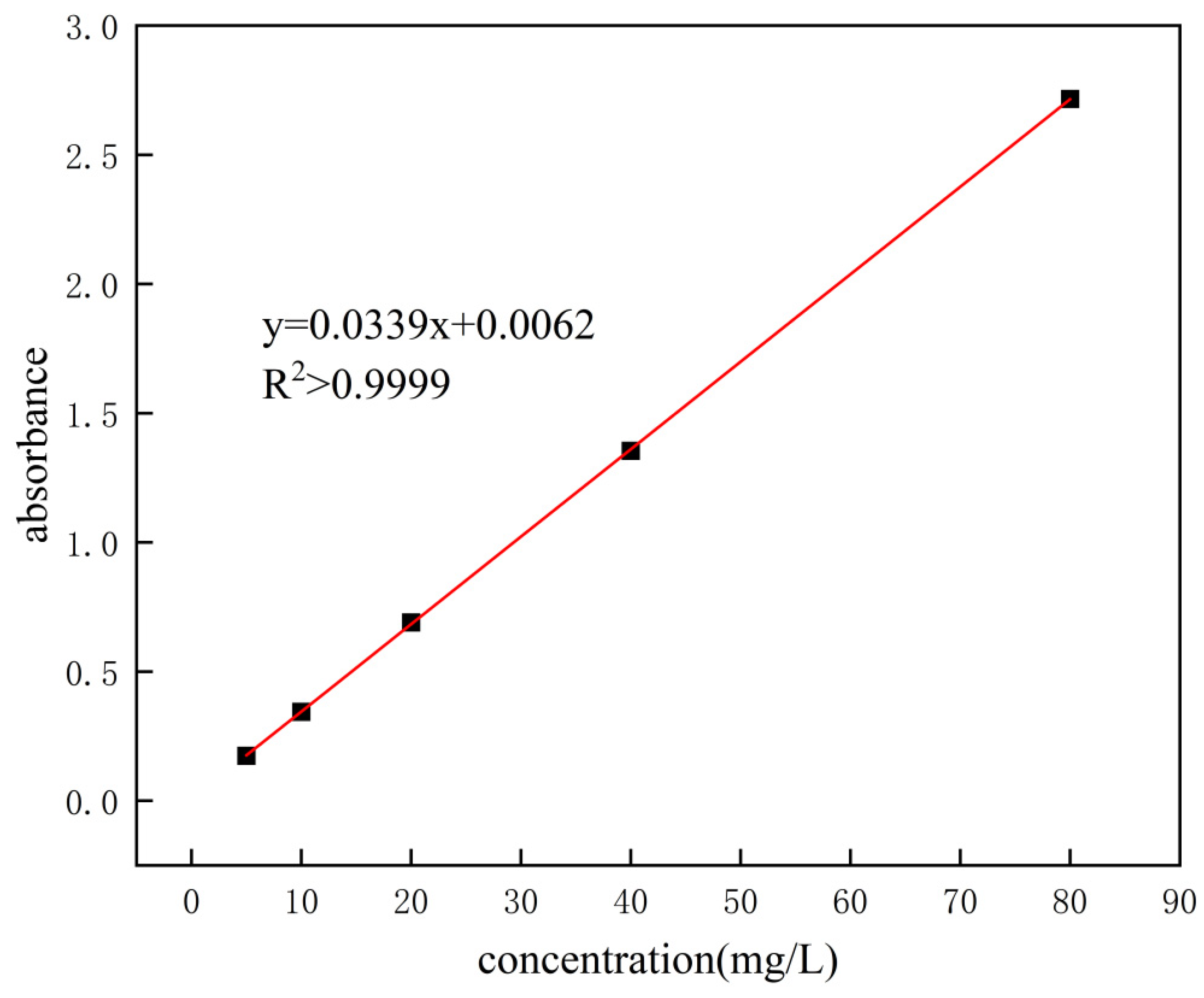
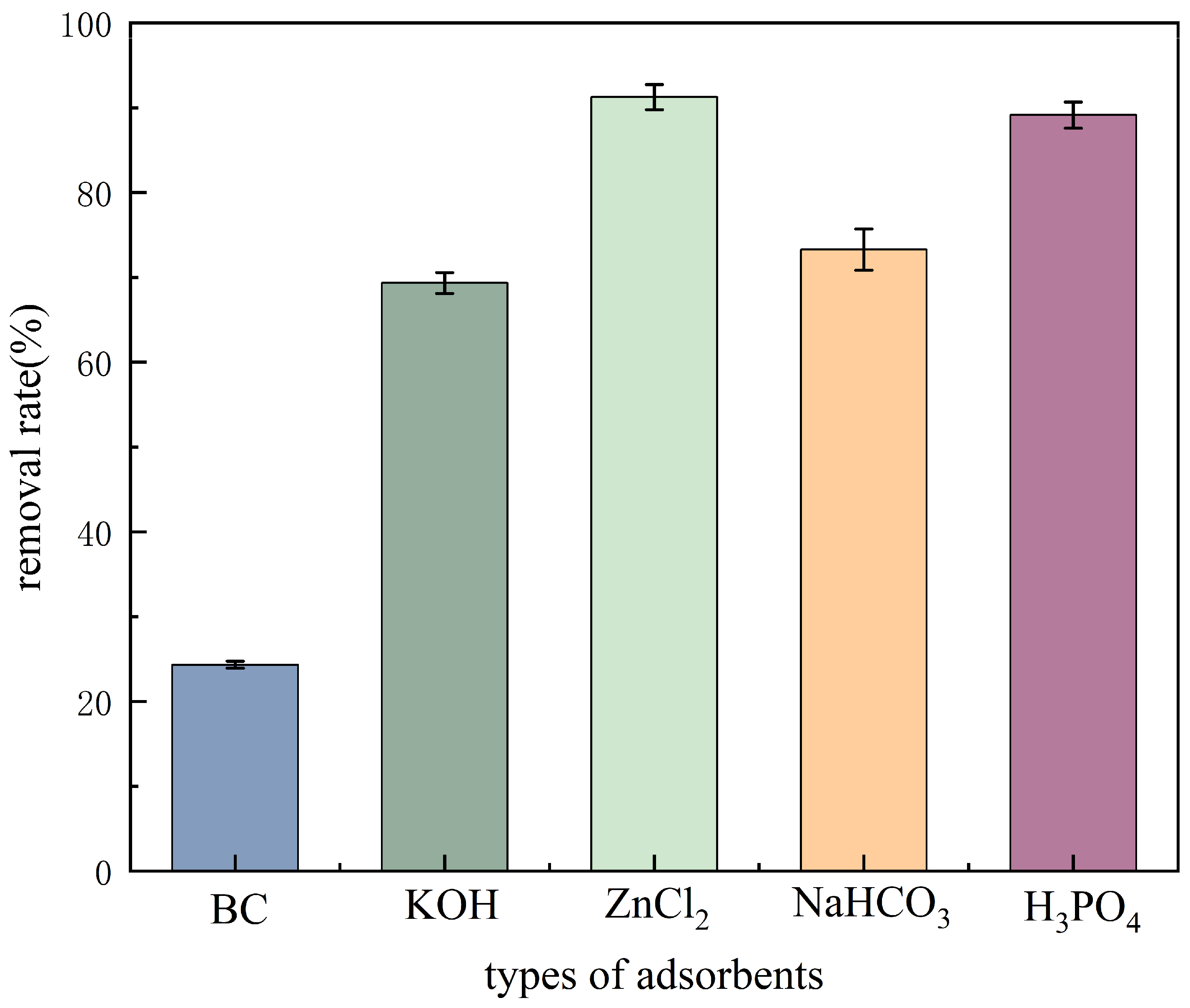



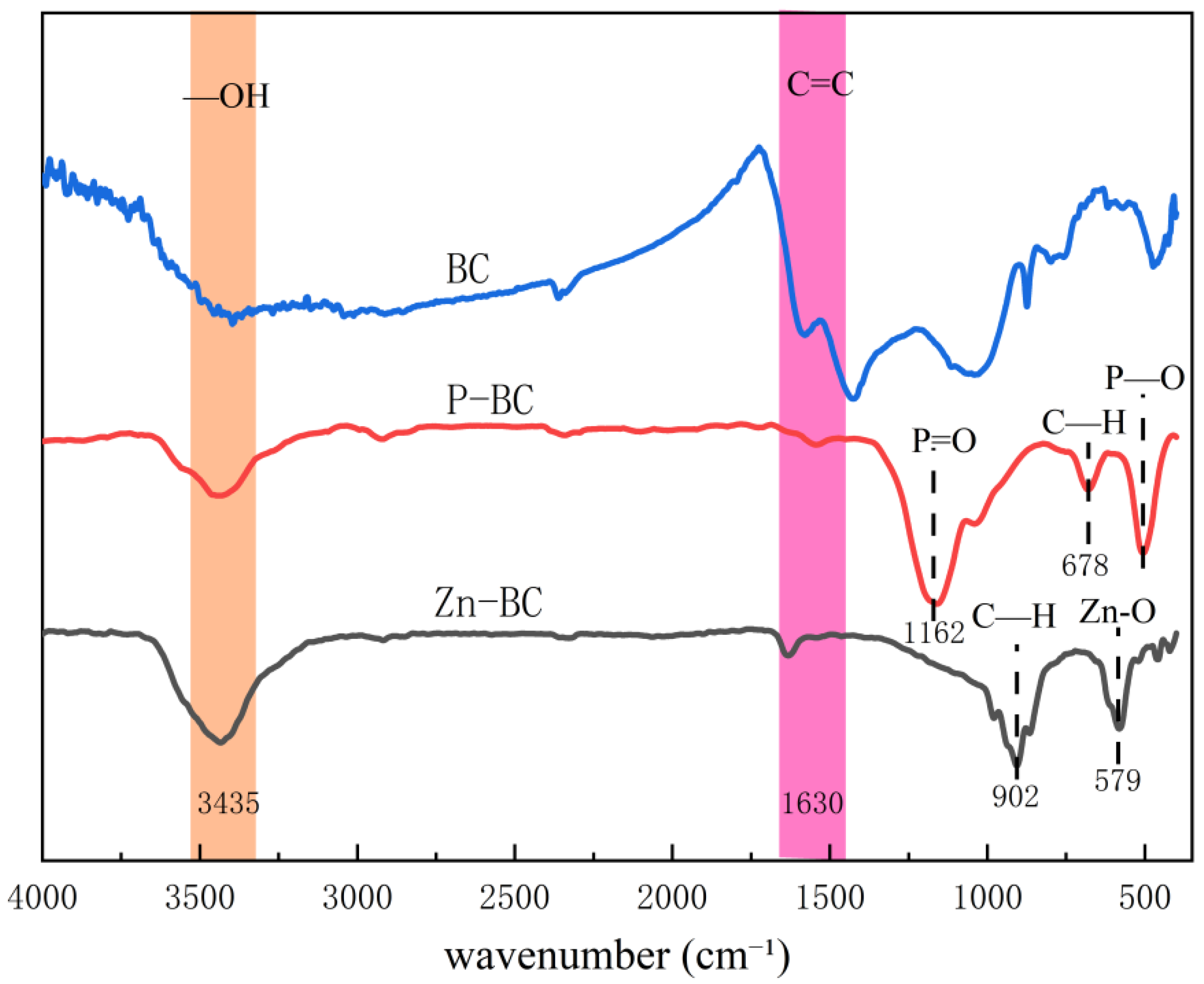



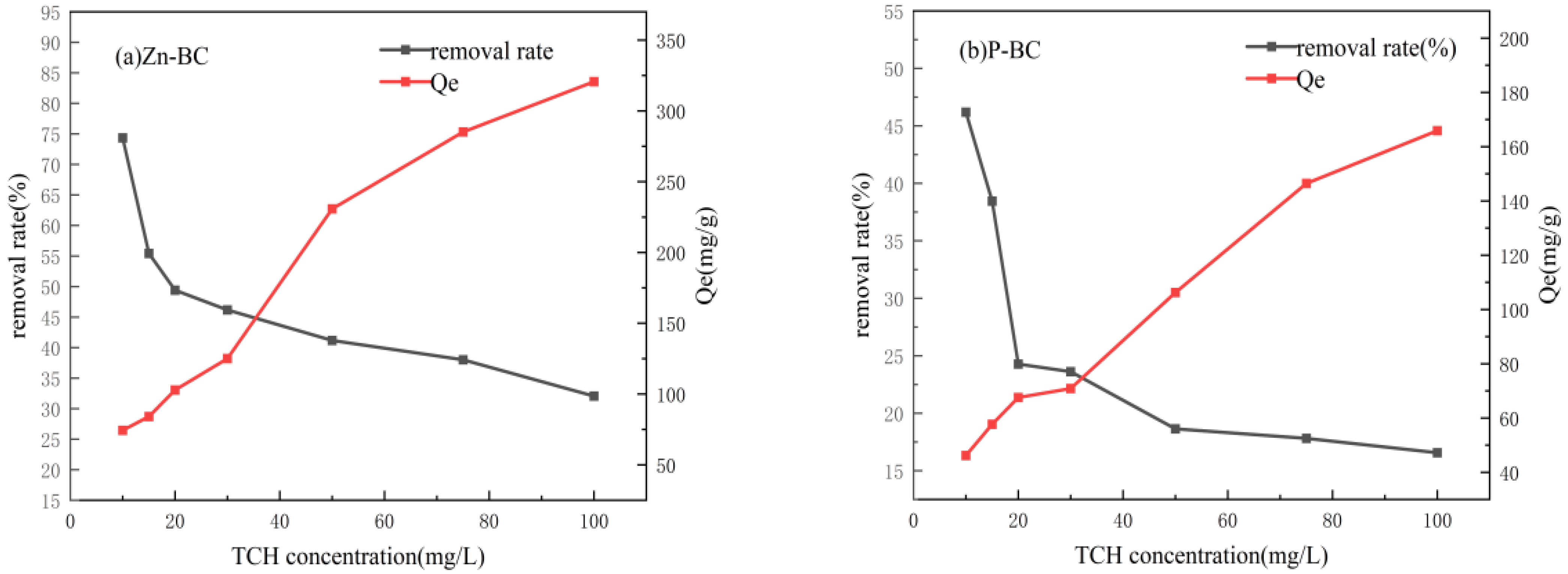

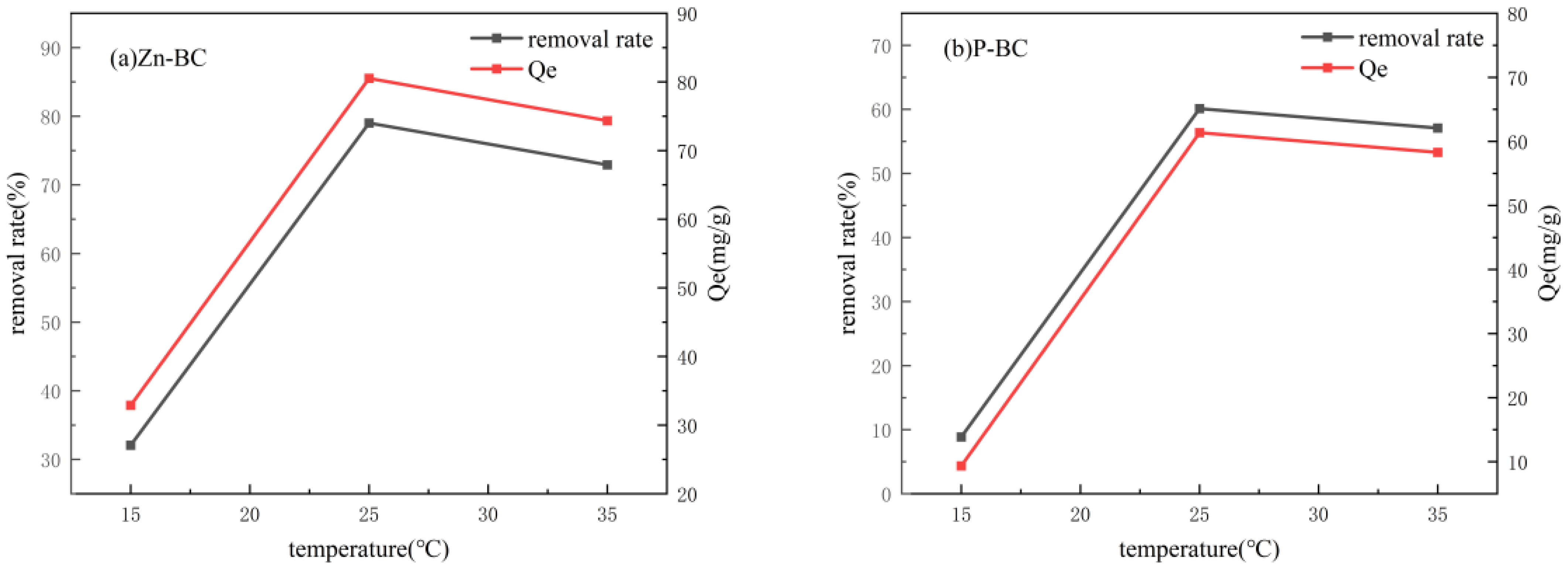
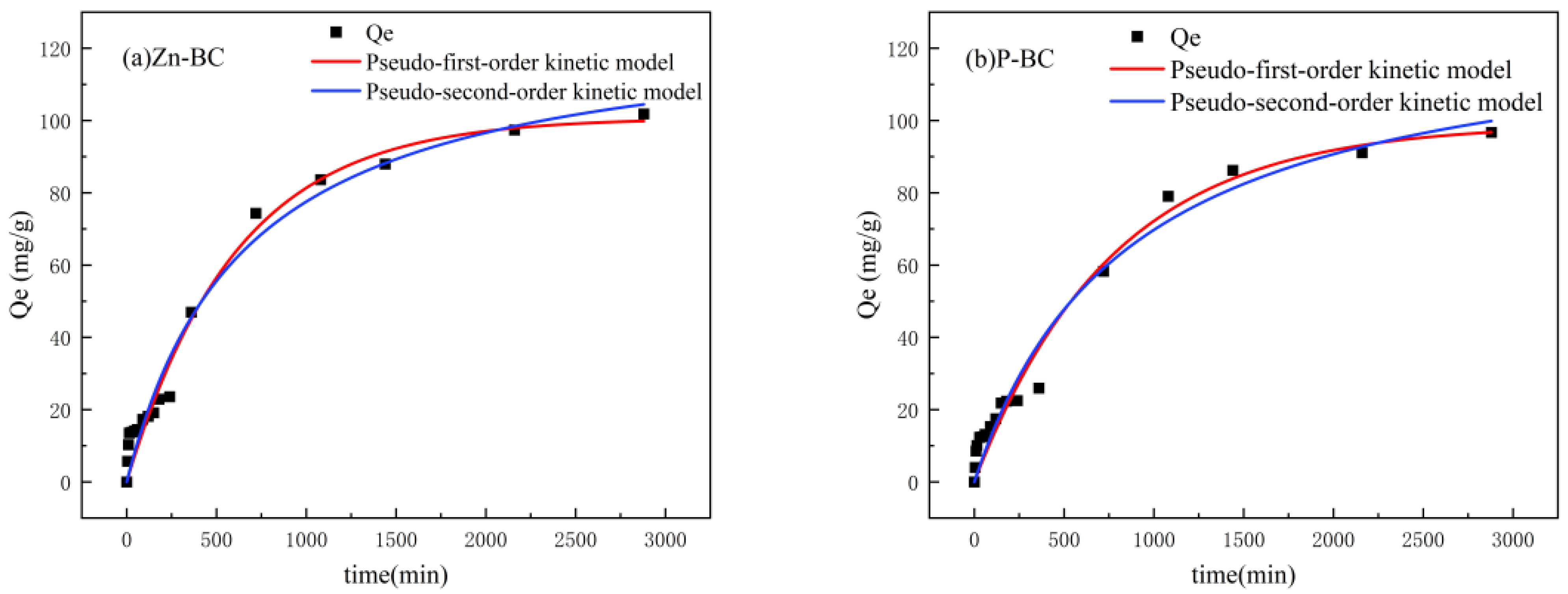

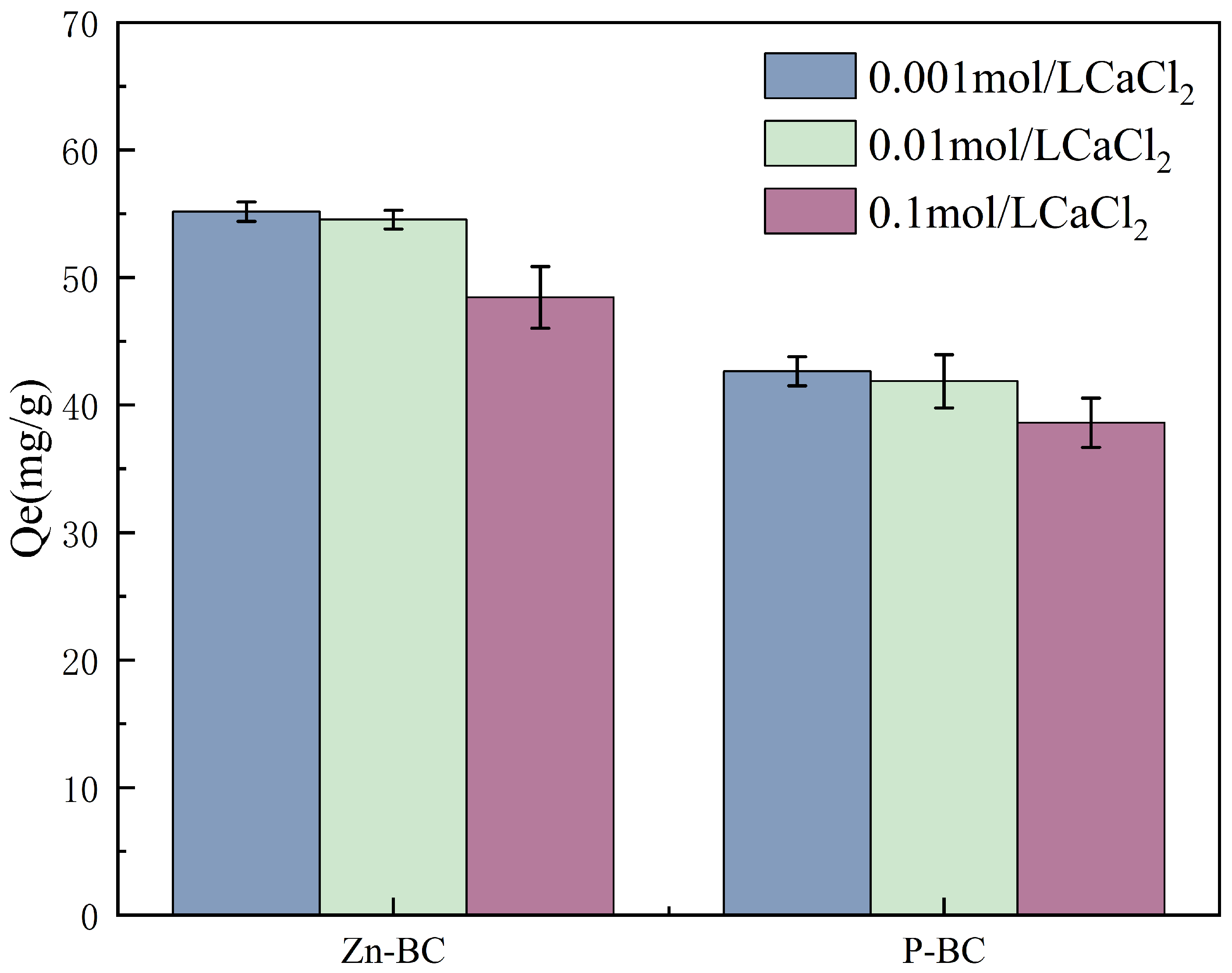
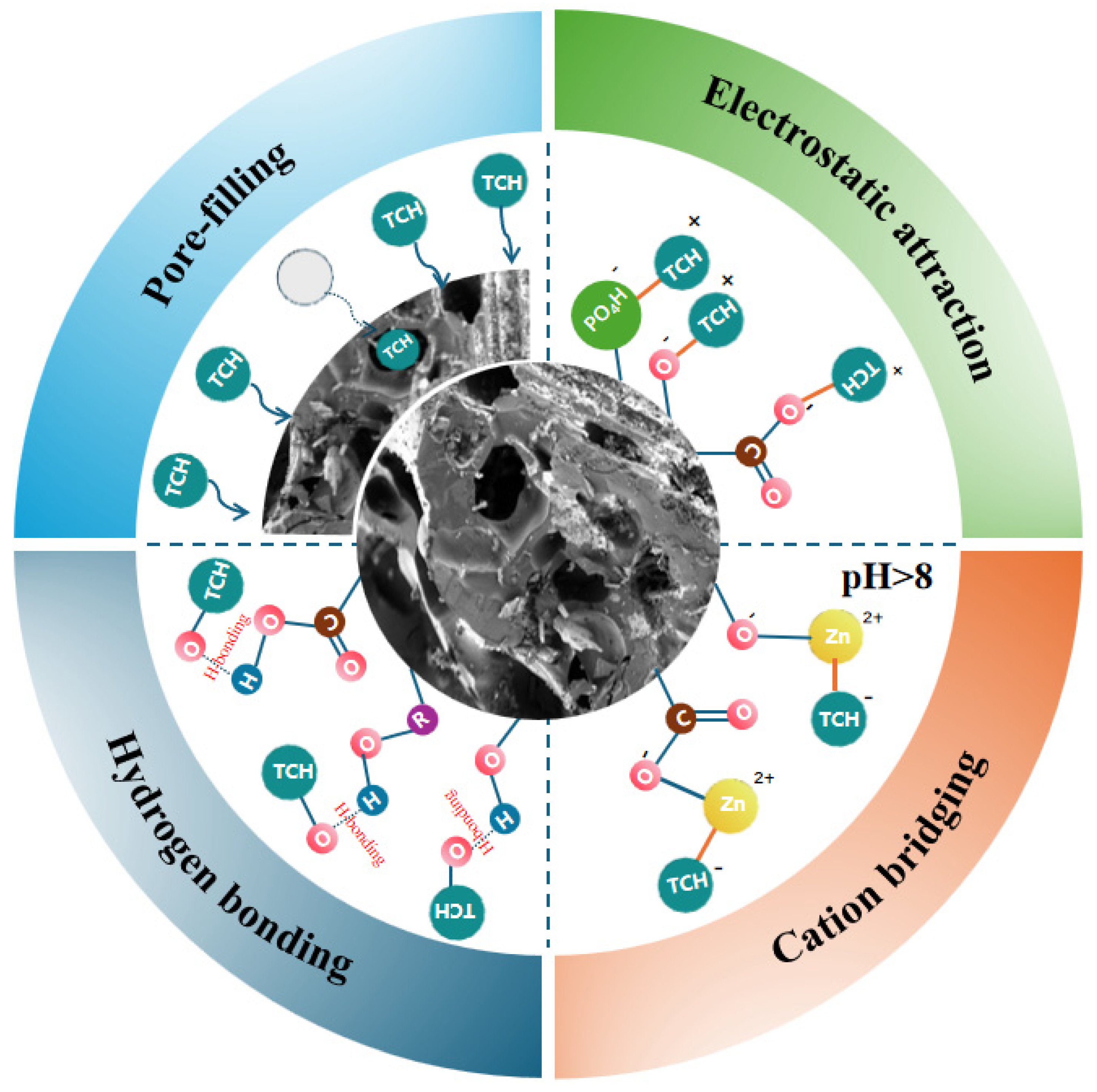
| Sample | SBET (m2·g−1) | Total Pore Volume (cm3·g−1) | Average Pore Diameter (nm) |
|---|---|---|---|
| BC | 112.65 | 0.08 | 2.97 |
| Zn-BC | 862.85 | 0.66 | 3.06 |
| P-BC | 404.58 | 0.30 | 4.30 |
| ∆S° (kJ·mol−1) | ∆H° (kJ·mol−1) | ∆G° (kJ·mol−1) | |||
|---|---|---|---|---|---|
| 15 °C | 25 °C | 35 °C | |||
| Zn-BC | 241.63 | 64.91 | −3.78 | −9.03 | −8.48 |
| P-BC | 338.55 | 96.38 | −0.06 | −6.77 | −6.68 |
| Modified Biochar |
Pseudo-First-Order Model |
Pseudo-Second-Order Model | |||||
|---|---|---|---|---|---|---|---|
| R2 | R2 | ||||||
| Zn-BC | 101.83 | 100.78 ± 4.19 | 0.0016 ± 1.8481 | 0.9729 | 128.15 ± 7.87 | 1.20 ± 2.59 | 0.9709 |
| P-BC | 96.73 | 99.10 ± 5.0 | 0.0013 ± 1.6486 | 0.9707 | 129.68 ± 9.64 | 8.97 ± 2.24 | 0.9690 |
| Modified Biochar |
Freundlich Model |
Langmuir Model
| ||||
|---|---|---|---|---|---|---|
| n | R2 | R2 | ||||
| Zn-BC | 23.47 ± 4.94 | 1.61 ± 0.14 | 0.977 | 531.41 ± 78.26 | 0.021 ± 0.0059 | 0.970 |
| P-BC | 13.92 ± 2.71 | 1.79 ± 0.16 | 0.975 | 252.37 ± 46.61 | 0.021 ± 0.0079 | 0.919 |
Disclaimer/Publisher’s Note: The statements, opinions and data contained in all publications are solely those of the individual author(s) and contributor(s) and not of MDPI and/or the editor(s). MDPI and/or the editor(s) disclaim responsibility for any injury to people or property resulting from any ideas, methods, instructions or products referred to in the content. |
© 2025 by the authors. Licensee MDPI, Basel, Switzerland. This article is an open access article distributed under the terms and conditions of the Creative Commons Attribution (CC BY) license (https://creativecommons.org/licenses/by/4.0/).
Share and Cite
Song, J.; Xi, H.; Gu, X.; Xiong, J. Study on the Adsorption of Tetracycline Hydrochloride in Water by Modified Highland Barley Straw Biochar. Water 2025, 17, 3335. https://doi.org/10.3390/w17233335
Song J, Xi H, Gu X, Xiong J. Study on the Adsorption of Tetracycline Hydrochloride in Water by Modified Highland Barley Straw Biochar. Water. 2025; 17(23):3335. https://doi.org/10.3390/w17233335
Chicago/Turabian StyleSong, Jiacheng, Huijun Xi, Xiaogang Gu, and Jian Xiong. 2025. "Study on the Adsorption of Tetracycline Hydrochloride in Water by Modified Highland Barley Straw Biochar" Water 17, no. 23: 3335. https://doi.org/10.3390/w17233335
APA StyleSong, J., Xi, H., Gu, X., & Xiong, J. (2025). Study on the Adsorption of Tetracycline Hydrochloride in Water by Modified Highland Barley Straw Biochar. Water, 17(23), 3335. https://doi.org/10.3390/w17233335






